
|
 |

|
 |
Art should be acknowledged as a life skill: Sangeeta Isvaran - Lalitha Venkat, Chennai e-mail: lalvenkat@yahoo.com January 23, 2005 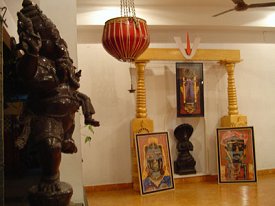 On behalf of Arangham Trust, Anita Ratnam presented a performance by Chitra Sundaram in 2003 December, to a select few invitees at the dance space in her residence. This year, on January 7th, Sangeeta Isvaran treated us to a traditional Bharatanatyam piece as well as some special items incorporating Indonesian style of dance. These are part of a work in progress. The music combines Indonesian gamelan and South Indian Carnatic. Artist V V Ramani's collages lent ambience to the performance space. Sangeeta has trained in Bharatanatyam for over 20 years under many eminent gurus including Kalanidhi Narayan, Savitri Jagannath Rao, C V Chandrasekhar, Bragha Bessell and Priyadarshini Govind, to name a few! She was one of the candidates selected from South Asia for the Asia Fellows Program in 2000. She has trained in Indonesia, Cambodia, Thailand and Burma, and also documented her observations. Sangeeta continues to visit the South Asian countries regularly to study and conduct workshops. She likes to work for social causes whenever she can. In India and abroad, she has worked with children within the regular school framework as well as with street children, with commercial sex workers and inmates of drug rehabilitation centers. Sangeeta talks to us about her work. Can you tell us about what you performed this evening? I performed 3 pieces. The first one was a traditional padam/keerthanam on 'Neelakanta Shivan' inspired by Ramani's collage of the lingam. The next 2 pieces are part of my work titled 'Mukh-Mukha-Mukhaa' - different words from Khmer, Sanskrit and Indonesian. It was commissioned by a French theatre. One is inspired by the stupidity of general communal violence, like in Maluku (Indonesia) between Christians and Muslims, or in India between Hindus and Muslims. It's about how religion, which is supposed to invoke peace, invokes violence, fanaticism and hatred instead. I generally use agarbathis to give that atmosphere, but I need an entire hour to get to that part, which I did not have now. I call this piece 'Faces of hatred, Faces of love.' The last item is called 'Bhumi Pranaam' - salutation to the earth - based on all the different traditions in Asia. In all, dancers touch the earth and only then start to perform. I picked up the vibrations of the different styles and made my own choreography. 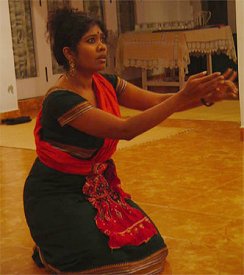
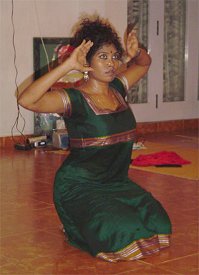
Why did you choose to learn the dance forms of South Asia? If I wore a cloth on my face and danced, nobody would be able to guess what I was trying to convey. That's my Bharatanatyam training. I wanted to look into other ways in which I could express myself. I could not find what I was looking for in western forms, so I chose to explore how other Asian traditions use their body to emote. Being a Bharatanatyam dancer, how easy was it to learn the Indonesian and Cambodian styles? Very easy! I have done Martha Graham, modern technique as well. That's really alien to our Indian culture - for me at least, for my body. It's very interesting and I learnt a lot, but it's still difficult. In any kind of Asian style, be it Indonesian, Thai or Cambodian, there's a certain difficulty for certain movements, there are different kinds of being supple, in different ways, like the way the hands curve back completely...but the aesthetic remains the same. I don't feel strange at all doing Balinese dance. My teachers are really surprised. "How can you pick up so fast?" they ask me. The feeling is not so different. While they did correct my position a little bit, elbows up or elbows down depending on the style, the feeling and aesthetics are exactly the same. It's the same with African as well. For how many years have you been training in these dance forms? For the past 5 years. I have been studying the dance forms of the South Asian countries, especially Indonesian and Cambodian, ever since I got my Fellowship. Only recently have I found the confidence to independently choreograph items in these dance forms. In what I did this evening, I have tried using a few Bharatanatyam movements, but in a soft manner, so they blend into the graceful Indonesian movements. 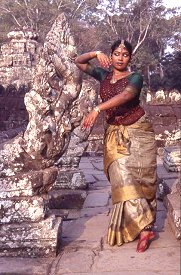 At Angkor The Indonesian form of Ramayana was a success when you presented it a year or so ago during the season at Bharat Kalachar. Yes, it was. Would you present it again? I would if given the opportunity. That time it was a group effort, but I am looking more at a solo presentation now. I have already presented my work in Croatia, France and other European countries. 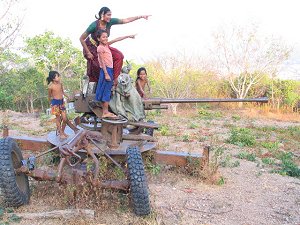 Phnom Bok - with children What are you working on at present? I have 4 to 5 projects running parallel right now. One project involves Africa-Indonesia-India. I've worked with an African choreographer and Indonesian choreographer. It is funded by the French govt and the project will come together in Indonesia only in Feb 2006. I am also writing for the UNESCO Arts in Education using rasa theory as well as techniques based on rasa. I work basically with underprivileged people - sex workers, street children, abused children, drug addicts - things like that. I am working on my solos based on the work I'm doing with different styles in Africa, Asia and India. I'm doing a theatre piece with Cambodian people with AIDS. I was just working with them and it came out so well, professionally speaking, because they are not trained dancers. The French want to make a film on that in Cambodia, both for educational purpose as well as because it's a really fantastic piece of dancing. It should go on TV. There's a French film being made on Indian dance. They have asked me to be the presenter. I will be speaking on Indian dance, presenting the whole concept of development of this tradition in South India as well as its contemporary variations that we see today. You are doing so many things, but we have not seen you perform this season. I went to Indonesia for my guru Didik Nini Thowok's 50th birthday celebrations. It was wonderful. Back home, I have been down with a parasite attack from my trip to Africa. Earlier, I did approach a few sabhas but they were not enthusiastic about it. I even offered to do Bharatanatyam for one half of the program and my Asian dance forms in the other half, but I was told the aesthetics did not go with the season's expectations! What did you think of this season? I have attended more music concerts than dance. I'm really disappointed with the sabha scene as well as the kutcheri scene. I feel it's been a low season. We see a lot of group dancing - everyone wants to do jal jal natyam, in the process of making it more 'attractive' for people. You always say 'the common man,' but you become common because you want to apply to the lowest common denominator... I am very disappointed by all the discussions happening this season. We have to accept that when something requires thought, less people are going to come and watch it. If you are going to apply this Prabhudeva / Bollywood kind of thing, everybody will come and watch because it doesn't require any energy on their part. But the minute you ask them to think, ask them to feel, ask them to sit and really do some work as an audience, as a rasika, people are just not willing to do that. You have to earn that title of rasika. Let's face it. Any thinking, sophisticated dance form or music will have less people. You don't really need an entertainment scenario to get a big crowd. Sometimes, even for big dance dramas, you find 10 people in the audience, because the quality is just...!! Can you describe your work with children? Art should be acknowledged as a life skill. I want to help children learn to access energy buried deep inside, so they can grow into healthy, happy, well-balanced individuals, able to support themselves in a world that is increasingly cruel, intolerant and filled with conflict. We can collectively pool our knowledge, create awareness of the needs of various groups, and launch successful programs that would benefit thousands of children. Contact: e-mail - issangeeta@yahoo.com |